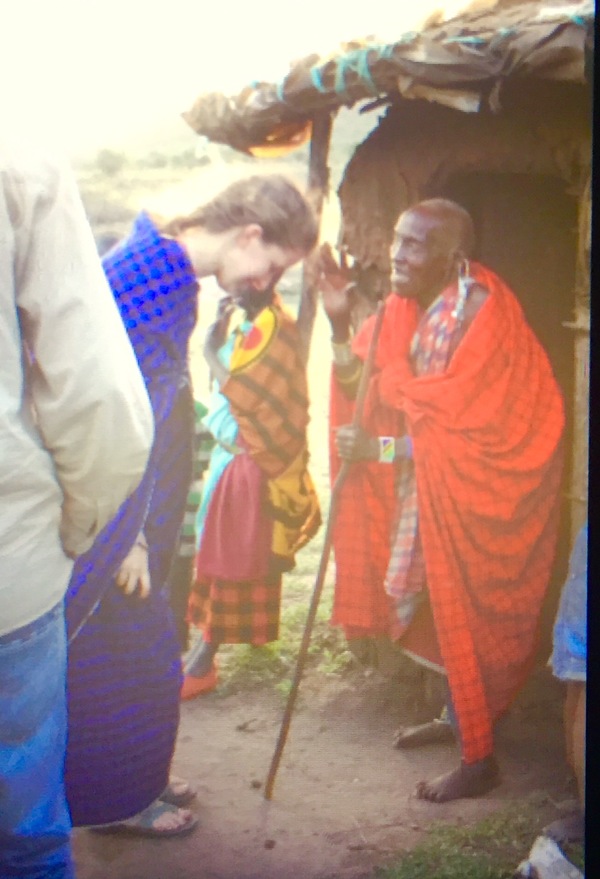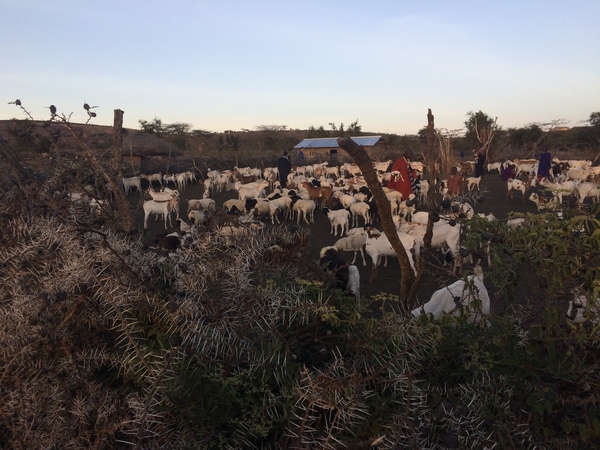The blue smoke swirls out of the short doorway, revealing the face of a small, wrinkled woman. This is the grandmother ("koko") of our guide, Killing-ot, a woman he boldly claims is over 100 years old and still cooking for herself. We, the students, meet her with reverence, bowing our heads down so she may gently lay her hand upon us and welcome us to the place she has called home for a century. Much has changed in these past generations for the Maasai in terms of their relationship to the outside world, yet as we meet Killing-ot's family in their boma they seem as timeless as ever.
As we cycle through the greeting line, the mooing of cattle, the bleating of goats, and the jingle of cowbells is overbearing as the livestock come in from grazing the fields to safely retire for the night in their "kraal." The young Maasai men and headers use their long, smooth rods to lead the cows from going astray, as the baby goats and calves topple over each other and their gangly legs to find their mamas. Because of the drought this season, these livestock look skinny but are still beautiful with their wet, pink noses and dewy eyes, and more importantly, they ensure their owners have milk to drink and meat to eat.
We meet the rest of Killing-ot's family on our tour of the boma, and thank them for their kindness by giving gifts of sugar and tea. The smiles of the people we meet match Killing-ot's toothy grin and makes us smile in return. We can't say much beyond our introductory "tekwenyas" and "supais" but smiles surpass boundaries and the hospitality is unforgettable. A swaddled baby giggles from its wrap on a mamas back and children run circles around us.
As we leave the boma to walk back across the mossy grass to our tents, I look up. The moon has just started the rise above the far tree line and casts a warm glow on it all. The sky is a gorgeous layer of pastels that starts on the horizon and weaves pinks and yellows upward into the dark nothing. The moon is so full and bright that you can see all the shadows on it as if under a microscope. Its transparent brightness seems to reflect how beautiful and clear life is here.
As I stand by myself taking this in, I look out and see the land of Loliondo, a place in Tanzania that has been challenged by governmental attempts to displace the Maasai people in order to favor hunting tourism. But, the people were able to resist and Loliondo has remained the home for the Maasai, though it is feared they will be forgotten. As I look behind me back on the boma full of the headers and baby calfs, swaddled babies and smoky houses, I don't see hardship; I see resilience and strength--in the faces of the people we met and etched on the unchanged landscape. The cowbells start to fade, and the sun slips under the horizon. This is a more beautiful image than a camera could ever take. The feeling of gratitude and a full heart welled up inside of me as I mentally capture the moment. As I turn back to the tents to join my group eating a warm dinner, one last young herder-boy comes in from the meadow in front of me and bows his head for me to greet him. I place my hand and thank him quietly. He smiles at me as he walks into the dusk. As the dark sets in behind him, what I've just experienced is pondered and gathered in my heart. Not to be forgotten, just like these people or Loliondo.





